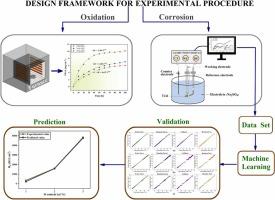深入了解Si合金TiAl合金的高温氧化和电化学腐蚀行为,并使用机器学习方法预测腐蚀行为
IF 6.3
2区 材料科学
Q2 CHEMISTRY, PHYSICAL
引用次数: 0
摘要
研究了at的抗氧化性和耐电化学腐蚀性能。% Ti-46Al, Ti-46Al- 1si和Ti-46Al- 2si合金。Ti-46Al- 2si合金的高温氧化倾向最小,Ti-46Al- 1si次之,Ti-46Al次之。这一结果表明,硅的加入在增强抗氧化能力方面起着关键作用,其特点是氧化速率常数最低,形成相对致密和更粘附的氧化层,可以作为氧气进入衬底的屏障。在所有合金的腐蚀性能比较中,Ti-46Al-2Si合金的腐蚀速率(Rcorr)值最低,为0.1199 mm/年。电化学阻抗谱(EIS)结果表明,硅的掺入使相最大值升高,相角变宽。Mott-Schottky分析表明,Ti-46Al-2Si合金表面形成的膜缺陷密度最小,表明Si的加入对合金的腐蚀行为有积极的影响。采用机器学习方法对TiAl合金的腐蚀行为进行了预测。包括额外树(ET)、随机森林(RF)、CatBoost和决策树(DT)在内的机器学习算法已成功用于预测合金的腐蚀行为。额外树回归模型对所有合金具有最高的预测精度。此外,目前的研究揭示了机器学习模型在预测腐蚀行为方面的潜力。本文章由计算机程序翻译,如有差异,请以英文原文为准。

Insights into the high-temperature oxidation and electrochemical corrosion behavior of Si alloyed TiAl alloys and the prediction of corrosion behavior using machine learning approaches
This study investigates the oxidation and electrochemical corrosion resistance of at.% Ti-46Al, Ti-46Al-1Si and Ti-46Al-2Si alloys. Ti-46Al-2Si alloy presented the least tendency for high-temperature oxidation, followed by Ti-46Al-1Si and then Ti-46Al. This result indicates that Si addition plays a key role in enhancing oxidation resistance, which is characterized by the lowest oxidation rate constant and the constitution of a relatively denser and more adherent oxide scale that may serve as a barrier to the ingress of oxygen into the substrate. In the comparison of corrosion performance among all the alloys tested, the Ti-46Al-2Si alloy presented notable results, exhibiting the lowest corrosion rate (Rcorr) value of 0.1199 mm/year. According to the electrochemical impedance spectroscopy (EIS) results, incorporating Si yielded a raised phase maximum and a broadened phase angle. Mott-Schottky analysis indicates that the surface film developed on Ti-46Al-2Si alloy has the least defect density, indicating that the corrosion behavior of the alloy is influenced by the incorporation of Si in a positive way. This study also focuses on predicting the corrosion behavior of TiAl alloys by adopting machine learning (ML) approach. Machine learning algorithms including extra trees (ET), random forest (RF), CatBoost and decision tree (DT) have been successfully employed to predict the corrosion behavior of the alloys. The extra trees regressor model has the highest predictive accuracy for all alloys. Additionally, the current study reveals the potential of machine learning models to predict corrosion behavior.
求助全文
通过发布文献求助,成功后即可免费获取论文全文。
去求助
来源期刊

Journal of Alloys and Compounds
工程技术-材料科学:综合
CiteScore
11.10
自引率
14.50%
发文量
5146
审稿时长
67 days
期刊介绍:
The Journal of Alloys and Compounds is intended to serve as an international medium for the publication of work on solid materials comprising compounds as well as alloys. Its great strength lies in the diversity of discipline which it encompasses, drawing together results from materials science, solid-state chemistry and physics.
 求助内容:
求助内容: 应助结果提醒方式:
应助结果提醒方式:


